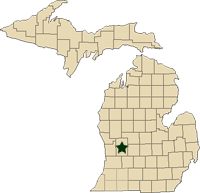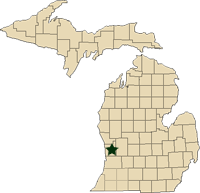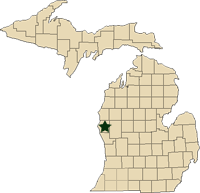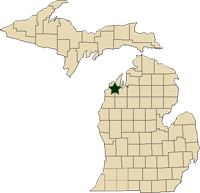Regional reports on Michigan fruit - May 24, 2011
MSU Extension educators’ pest and fruit updates for Michigan.
This week’s regional reports:
- Southwest Michigan - Mark Longstroth, Bill Shane, Diane Brown-Rytlewski
- Southeast Michigan – Bob Tritten
- Grand Rapids Area Tree Fruit - Amy Irish Brown, Phil Schwallier
- Grand Rapids Area Small Fruit – Carlos García-Salazar
- West Central Michigan - Mirjana Bulatovic- Danilovich
- Northwest Michigan - Nikki Rothwell, Erin Lizotte, Duke Elsner
Southwest Michigan – Mark Longstroth, Bill Shane and Diane Brown, Michigan State University Extension
|
Last week was cool with a warm weekend. Highs rose from the 60s to the 80s on Sunday (May 22). Strong storms moved though the region Sunday evening, causing more fire blight infections in apples and pears. Rainfall totals across the region ranged from less than an inch to 2 inches. This week will be cooler with continued unsettled and rainy conditions. High temperatures should stay in the 60s. Soils are still wet. Most sites have received over 10 inches of rain since March 1. Soil temperatures are in the mid-60s. We are still a week behind average for fruit development. Check for the closest weather station at Enviro-weather.
| Southwest Michigan Growing Degree Day Totals from March 1 through May 22, 2011 | |||
| Location | GDD 42 | GDD 45 | GDD 50 |
| SWMREC | 535 | 411 | 254 |
| Trevor Nichols | 488 | 377 | 237 |
Tree fruit
The fruit set for some crops is variable. Eastern tent caterpillar webs are becoming noticeable. Plum curculio is a concern when stone fruit emerge from the shuck. Egglaying by this pest has not yet been reported in tree fruit. Be sure to protect your fruit before the warmer weather this weekend. Oriental fruit moth was biofixed in early May (May 8) and we are about 220 GDD base 45 after biofix, and egglaying has begun. When mowing orchard cover crops, tarnished plant bug will migrate from blooming cover crops to trees and feed on developing fruit. We are just starting to catch codling moth adults but have not set a biofix.
Aricots have emerged from the shuck. The largest fruit are 14 mm in diameter.
Peaches are at shuck split. Peach leaf curl symptoms are much more noticeable and showing up in area orchards that were treated for this disease, with copper programs having poorer results. The cool, wet spring was favorable for this disease. Numerous wetting events probably washed off some chemical control. Copper programs to suppress bacterial spot are continuing. Controls for oriental fruit moth should be applied soon in young peach orchards where pheromone disruption is not being used.
Sweet cherries are 12 mm in diameter. Some varieties have lighter sets. Sweet cherries are always susceptible to brown rot infection in warmer rains. Sweet cherries are also susceptible to cherry leaf spot.
Tart cherries are in two sizes: the larger fruit are 8 mm in diameter and the smaller fruit are in the shuck. The crop does not appear to be heavy. Cherry leaf spot is the major cherry disease in Michigan cherries and there have already been several cherry leaf spot infection periods since the leaves have unfolded. Growers need to protect against plum curculio.
Plums are in the shuck. Growers need to maintain black knot controls during shoot growth. Plum curculio is a concern after shuck split.
|
Apples still have some straggling bloom, but generally bloom is ending. The largest fruit is 4 to 8 mm in diameter depending on the variety. The sepals on the king blooms are folding up indicating good fruit set. Thunderstorms over the weekend probably caused fire blightblossom blight symptoms should be visible from the May 11 infection. Symptoms from the May 12 infection will be delayed by cooler weather this week and should appear Thursday. Many growers have applied antibiotics two to four times and many used Kasumin. The Interactive fire blight tool on Enviro-weather can be used to forecast when symptoms will appear. infections on Sunday and Monday. Fire blight
Apple scab symptoms are easy to find on unsprayed trees, but growers have not reported symptoms in their orchards. It is important to maintain fungicide coverage as not all the scab spores have been released. Growers can use the scab infection tool on the Enviro-weather website to track infection periods.
Powdery mildew is a concern on susceptible varieties. Apple thinning will be poor this week due to low temperatures. A good thinning window with highs into the upper 70s is forecast for the Memorial Day weekend. Growers need to be aggressive as it appears the entire state will have a heavy crop similar to 2009.
Insect activity in apples will increase with warmer temperatures. Codling moth has been caught in Berrien County. Plum curculio and tarnished plant bug are concerns when temperatures rise higher and fruit start growing. Aphids and leafrollers can be found in many orchards.
Pear bloom is ending. The major pear varieties are susceptible to fire blight and pear scab which is similar to apple scab. Pear growers should use the apple tools for these diseases to help plan their control strategies. Pear psylla egg laying was heavy during the hot weather.
Small fruit
Grape shoots are 4 to 10 inches long with three to four leaves out. The flower clusters are elongating. There are three to four flower clusters per shoot. Vinifera and French hybrid vines have less growth. During the shoot growth period before bloom, the primary focus is on disease control. It is important to get fungicide coverage to control phomopsis infections as the flower clusters are exposed. Phomopsis symptoms are visible on leaves and leaf stems of unsprayed grapevines of several cultivars. Grape berry moth adults are being trapped. There is no need to spray until after bloom. A grape berry moth predictive model is available on Enviro-weather. Biofix for grape berry moth is determined by the date when 50 percent of flowers are open on 50 percent of the clusters of wild grape (Vitis riparia). The second and third generations of grape berry moths are of most concern. Second generation grape berry moths egglaying starts at 810 GDD base 47 and third generation grape berry moths at 1620 GDD base 47 after biofix.
Cronenwett Farms will host the June 8 grape meeting that will focus on crop load management. This meeting will also begin with lunch at noon followed by programs until 3:00 PM. Cronenwett Farms is located at 70121 28th St. Lawton, Mich. So we can plan meal counts, please register in advance with Linda Gustafson at the Berrien County MSUE office (269-944-4126). Checks should be made out to Berrien County MSUE and mailed to 1737 Hillandale Rd, Benton Harbor, MI 49022. Registration includes lunch, and is $15 per person/meeting if paid in advance, or $20 if paid the day of the meeting.
|
Blueberries are blooming. Early varieties such Bluetta are past bloom and have small green fruit. Bluecrop is at early petal fall. Jersey and Elliot are at full bloom. Water is standing in many fields. Winter injury symptoms are widespread and easy to find. Mummy berry shoot strikes appeared during bloom and were numerous last week. Strong winds associated with storms knocked off many of these fragile dried shoots off the bushes but a few remain. Blueberry flowers are susceptible to infection during pollination. There have been mummy berry shoot strike infections on the blossoms. Flowers are brown, some never developed. As bloom ends growers need to protect against anthracnose fruit rot and fruitworms. Both cranberry fruit worm and cherry fruit worm adults have been trapped. Growers need to trap to determine biofix and use the Enviro-weather models for fruitworms. Obliquebanded leafroller are causing distorted shoots.
|
Strawberry bloom continues but the primary and secondary blooms are finished and the green fruit is hanging down. The largest berries are thimble-sized. There is feeding injury by tarnished plant bug. Growers should be monitoring for tarnished plant bug. Temperatures have been warm enough for adult activity, and egg laying begins when temperatures get to 68°F or higher. Feeding by tarnished plant bug can cause death of the flowers or deformed fruit (button berries).
Brambles shoots are about 4 inches long. Winter injury to raspberries and particularly blackberries is wide spread. Flower clusters are emerging on the new shoots. New primocanes in fall bearing raspberries are almost a foot tall.
Southeast Michigan – Bob Tritten, Michigan State University Extension
|
Weather
Precipitation has been the feature story for fruit growers over the last week. There has been a band of very heavy precipitation running from Port Huron through the Flint area. To the south there have been frequent showers and wetting events, but much less total rainfall. The story is the same as you move north from Port Huron to Flint. Rainfall totals at our weather stations in this band of heavy precipitation have ranged from 2.5 inches for Emmett to a little over 5 inches for Romeo. Many fruit growers have shared rainfall totals over the last 12 days ranging from 4 to 7 inches.
We have had an extended bloom period on many of our tree fruit crops. This has been a very challenging time for apple scab and fire blight control in apples as well as other disease problems in strawberries and blueberries.
Our season is still running about a week behind normal when I look at growth stages for most of our fruit crops. The exception is strawberries which are running close to two weeks behind normal. When I compare degree day totals to the five-year average at most weather stations, our season is running about eight to nine days behind normal.
Our soils are very wet in the middle of the region and field work will not commence for at least another week at many farms. There are still farms fighting to get tree and small fruits planted, but to no avail due to wet soil conditions.
Lastly, the order of flowering of many of our fruit crops is a bit out of sequence this year. I see that the same thing holds true for many ornamental trees and shrubs as well as forest trees. I am not quite certain what this means in terms of fruit production, but it is odd to see certain plants flowering at the same time as others.
| Southeast Michigan Growing Degree Day Totals March 1 to May 23 | |||
| Location | GDD42 | GDD45 | GDD50 |
| Commerce (Oakland) | 534 | 423 | 275 |
| Emmett (St Clair) | 513 | 405 | 260 |
| Flint (Genesee) | 565 | 449 | 299 |
| Lapeer (Lapeer) | 556 | 445 | 296 |
| Petersburg (Monroe) | 591 | 465 | 295 |
| Pigeon (Huron) | 442 | 342 | 212 |
| Romeo (Macomb) | 507 | 399 | 255 |
Tree fruits
Apples are at fruit set in the southern part of the region, at late bloom to petal fall in the middle of the region and at full bloom as you move toward the north. Many growers have seen an extremely long bloom period in apples this year. This is causing quite a challenge in terms of fire blight.
With all the wet weather many apple growers are concerned about fruit set. I would say that in the southern part of the region now is a good time to begin to assess fruit set for the year. First set and thinning decisions are always hard to make, but this year is going to be more difficult than ever. In the middle part of the region it is a bit early to begin trying to assess where we are at in terms of thinning and fruit set.
We currently have about 6 inches of new growth on apple shoots. Many growers applied Apogee over the last week to help reduce growth and also reduce the threat of fire blight. Apples have seen an explosive amount of new growth in many varieties.
New pests to report this week include codling moth and mullein bug. We had the first catch of codling moth on Monday (May 23) in a trap in a mating disrupted apple block. I expect to see codling moth trap catches climb steadily over the next week in blocks where mullein bugs have been a problem in the past, now is the time to control them. Oriental fruit moth trap catches have continued to be high in some blocks, and near zero in others. It appears that in blocks where mating disruption is in place there is little to no trap catch. Spotted tentiform leafminer and redbanded leafroller trap catches are down. I continue to see a few plum curculio and tarnished plant bugs in apples, I don’t think the numbers are high enough to cause a great concern at this time. Mite populations are generally low across the region. My overall observation is that insect populations are low at this time and many growers could consider delaying a petal fall application by a few days to wait for populations to build a bit. I continue to see a good number of predators in many blocks of apples.
Disease control has been a primary focus for apple growers over the last 11 days. Many of our Enviro-weather stations report five wetting events over this time period, with several having five apple scab infection periods. I saw my first apple scab lesions for the season in an abandoned tree early this week, and I had a couple of reports of a few apple scab lesions starting to show up in commercial blocks, however personally I have not seen any. With each rain event we continue to get apple scab spore release. The numbers of spores that are caught in traps are on the decline. We are not at the end of primary apple scab season. A concern I have about calling the end of primary apple scab season this year is that both of my apple scab trapping stations are in the region that had heavy rainfall over the last 11 days. This may mean that apple scab spore discharge has been heavier in this region and therefore primary apple scab season may end sooner here. Stay tuned for details. Fire blight has also been a concern for apple growers over the last few days. The EIP numbers have been well over 100 since Sunday at many of our Enviro-weather stations and it appears that those numbers will continue to be above 100 throughout much of this week and possibly even into early next week. With the lingering bloom that we have had many apple varieties, fire blight is a major concern to me.
Pears are at about 8 mm to 10 mm in size with some rag-tag bloom continuing. Pear psylla continue to be present. Numbers are generally much lower this year than they have been in the past several years. I continue to be concerned about fire blight with rag-tag bloom.
Peaches are not quite at shuck split yet for Red Haven, however several of the PF varieties are at shuck split. Tarnished plant bug continues to be seen in peaches, as do a few plum curculio. As stated earlier, oriental fruit moth trap catches are all over the board, but generally appear to be higher in peach blocks this year than apple blocks. Now is a critical time for brown rot control strategies.
Sweet cherries are generally at 7 to 11 mm with a wide range of fruit size. It appears that we have a good set on sweet cherries.
Tart cherries are approaching shuck split and appear to also have a fairly good crop.
Plums are at shuck split for European plums and just beyond shuck split for Japanese plums. I have not seen any plum curculio stinging in plums. I will continue to watch wild trees for egg laying activity.
Small fruits
Strawberries are approaching thimble-size fruit in the southern part of the region and at about 30 percent blooms in the middle of the region. My observation is that strawberries seem to have a lack luster look to their blossom, with most bloom being considerably smaller than I have seen over the last few years. A major concern in strawberry growing in the mid-region is the dramatic increase of slugs over the last week. This is the result of heavy rain falls. Now is an excellent time to control slugs. This is a pest that is going to bear watching throughout the rest of the spring. I continue to see a few strawberry clippers, but their numbers are generally low. Now is a good time for growers to scout for strawberry clipper presence and injury. With bloom approaching now is also an excellent time for fungicide applications to control grey mold. Unfortunately many strawberry fields are very wet and fungicide applications are almost impossible. I continue to see many fields with high populations of grass from straw mulch. Growers need to keep an eye on this as now is a good time to control it.
Raspberries are continuing to show extensive winter damage particularly to the tips of the canes. Now is a good time to remove the dead portion of the effected canes. The flower clusters are starting to be more visible in summer fruiting raspberries. Fall bearing raspberries have about 12” of new growth. The newest leaves look much better than the old leaves which are tattered due to strong winds when they were tender. Blackberries continue to show an extensive amount of winter kill, with many plants being killed for the Prime Jim and Prime Jan varieties.
Blueberries are fast approaching 25 percent bloom. I continue to see trumpets of mummyberry disease in the soil. Growers have needed to apply a couple of fungicides in the last 10 to 12 days to control mummy berry.
Grapes are at about 6 inches of new growth for Concord types with flower buds now plainly visible. French hybrid types have about 4 inches of new growth and buds are just starting to be seen.
Grand Rapids Area Tree Fruit– Amy Irish-Brown and Phil Schwallier, Michigan State University Extension
|
Tree fruit growth stages
Most apples in the region were in full bloom prior to the weekend of May 21 and are moving towards petal fall quickly with all the heat and rain of late. Fruit set appears to be heavy, but it’s very early to really assess very well.
Tree fruit pests
Apple scab. There have been four to five different rain events over the past 10 days depending on the weather station site. Most of these rain events resulted in apple scab infections. Apple scab ascospores continue to be caught and numbers appear to be tapering off, but primary scab season is still an ongoing situation and growers need to maintain appropriate fungicide rates.
Fire blight was a concern over the weekend of May 21 with quite a bit of open bloom remaining and temperatures in the 80s for a couple of days in a row. Some windy conditions were a part of the rains that moved through May 22 and 23, but no reports of hail. The threat for fire blight blossom blight infections was very high and hopefully growers covered viable bloom to prevent it.
Insect development in tree fruits has responded to the warmer weather. Spotted tentiform leafminer continues to fly and tissue feeders should be showing up soon. Obliquebanded leafroller larvae continue to be found in apple terminals in low to normal numbers. European red mites hatch is well underway. Rosy apple aphids are rolling up terminal leaves and green apple aphid should start to be found soon. Traps should be up for codling moth; there have been some reports of codling moth flight in hot spots. Mating disruption needs to be in place for codling moth and oriental fruit moth. Plum curculio activity in all tree fruits should be monitored as it could begin at any time. Oriental fruit moths continue to fly in numbers normal for this region. A biofix was set for the general Grand Rapids area for May 12; early egg hatch is expected to begin any day and cover sprays are important in stone fruits.
Grand Rapids Area Small Fruit– Carlos García-Salazar, Michigan State University Extension
|
Weather conditions in the central region remain unchanged. Daily temperatures remain low in comparison to 2010. During the past week, minimum temperatures observed in the area averaged 50°F. Meanwhile, maximum temperatures reached the lower 80s with an average temperature of 73°F. These temperatures are not much different from the previous week. Minimum temperatures have remained above the freezing point and no spring frost damage has been reported.
Regarding precipitation, during the past week there were days with no precipitation that allowed growers to get into the fields to initiate their pest and disease control program. In general, the amount of rain accumulated in central Michigan during the past week was less than 0.5 inches.
Given the prevailing environmental conditions, the amount of growing degree day (GDD) accumulation in the region as of May 23 reached 285 GDD (base 50°F) and 551 GDD (base 42°F). Despite the observed improvement in the environmental conditions, that GDD accumulation remains lower with respect of the previous season. Because of this difference in GDD accumulation, plant growth and development remains more than one week behind with respect to the 2010 growing season.
At this time, summer raspberries are in flower bud stage and fall raspberries are in 12 to 18 inches cane stage. There is no evidence of insects or disease problems and their growth is very healthy.
For strawberries, late season varieties are in the white bud stage. Early varieties on the other hand are in 50 percent bloom. No diseases of insect problems are present at this time.
Blueberry growth stages found at this time in the region goes from early bloom in late season varieties (Elliott) to 100 percent bloom in the most advanced varieties like Bluecrop.
Major problems observed across the region are related to winter damage. Damage is more evident in Jersey fields (Photos 1 and 2). Fields affected require extensive pruning of damaged tissues and fungicide treatment to prevent cankers. It is important to mention that any delay in initiating disease control may increase the risk of extensive mummy berry and phomopsis infections late in the season.
Regarding blueberry diseases, no more mummy berry mushrooms are observed, but in some fields mummy berry shoot strike infections are showing up. This is happening in fields where growers are having problems entering the field due to excessive water. For fields that are showing extensive dieback from winter damage, it is important to maintain an active disease control program to prevent further damage. Fields affected by spring frosts of winter damage always get secondary infections by phomopsis that uses damaged tissues as port of entry.
If you see dieback problems in your field and you are not sure if this is due to winter, mummy berry or phomopsis, please call your local county Extension office for assistance or take shoot samples and send them for identification to the MSU Diagnostics Lab. Products recommended for early season mummy berry and phomopisis control are Indar 2F (6 fl oz) or Indar 75 WSP (2 oz) or Orbit (6 fl oz). For a complete list of products and recommendations for mummy berry and phomopsis control, please follow MSU Extension bulletin E-154, 2011 Michigan Fruit Management Guide.
With respect to insect pest problems in blueberries, there are enough degree days accumulated for the beginning of the cherry fruitworm emergence. This has been already recorded in Van Buren County. At this time, cherry fruitworm traps should be already in place to detect the beginning of the emergence of the overwintering adults. Timely detection of sustained moth catch is necessary to synchronize our pest control measures with the cherry fruitworm egglying period. This is important for fields with a history of cherry fruitworm infestations.
On May 26-27, we will be conduction our third Good Agricultural Practices for food safety in berry production. The program starts with registration from 8:30 to 9:00 AM on May 26. The classroom program will be conducted at the Trevor Nichols Research Center in Fennville, Mich., and the hands-on training will be conducted at farms of growers attending the workshop. There is a $150 registration fee for the first person and $100 for the second participant from the same farm. This includes lunch and educational materials. For growers unable to pay the full registration fee there will be a limited number of scholarships. Space is limited so you must please pre-register by calling Judy Hanson at 616-994-4548 at the MSU Extension Ottawa County office in West Olive.
On June 1, we will be hosting another training workshop for berry growers interested in learning about the biology, monitoring and control of the spotted wing Drosophila. Growers, berry crop scouts, and IPM consultants should attend this workshop. Training will start at 9:00 AM with classroom training followed-up by hands-on field training from 1:00 to 5:00 PM. Participants will learn about how to identify this new insect, how to trap for it, and how to sample fruit. This program is designed for growers, scouts, and consultants to learn about spotted wing Drosophila before the field season starts, so management of this pest can be integrated into IPM programs. This training will be conducted at the Trevor Nichols Research Center in Fennville. There will be a $25 registration fee which includes lunch and educational materials. Space is limited so you must please pre-register by calling Judy Hanson at 616-994-4548 at the MSU Extension Ottawa County office in West Olive.
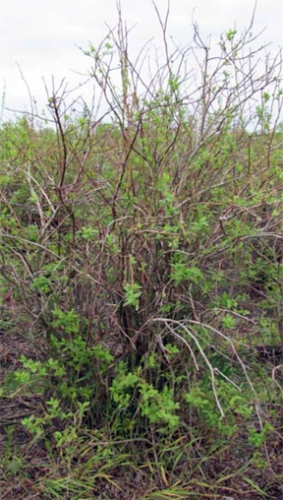
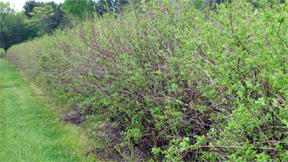
Photo 1 (Left): Winter damage in the Jersey variety in Allegan County. Photo credit: Carlos García, MSUE.
Photo 2 (Right): Winter damage in the Jersey variety in Ottawa County. Photo credit: Carlos García, MSUE.
West Central Michigan – Mirjana Bulatovic-Danilovich, Michigan State University Extension
|
West Central Michigan Tree Fruit Update -The weather conditions have been variable this past week. We had rain, high winds, and higher temperatures for a couple of days, then back to cooler temperatures again. There were four wetting events with scattered rains throughout the area and highly variable precipitation amounts.
Tree fruit
The weather conditions, particularly over the weekend, put the phenological development into fast forward. ApplesPears are three days past petal fall with some late blossoms still present in the blocks. Sweet cherries are 80 percent out of shuck with fruit size ranging from 5 to 10 mm depending on variety. Tart cherries are part petal fall and fruit is starting to swell. Peachesare in shuck. Apricots are out of shuck with 10 to15 mm in diameter. European plums are in shuck. moved from full pink - king bloom to petal fall in less than a week.
West Central Michigan Growing Degree Day Totals Since March 1 as of Monday, May 23.
| Location | DD42 | DD45 | DD50 | Rainfall | |
| Last Week | Since 4/1 | ||||
| Hart | 478 | 374 | 239 | 0.26 | 5.38 |
| Ludington | 459 | 358 | 228 | 0.14 | 6.45 |
| Bear Lake | 465 | 365 | 234 | 0.43 | 6.97 |
Insects
Insects are becoming more active. Scouts have reported finding European red mite nymphs and a few two-spotted mites. Rosy apple aphids are starting to build up their colonies. Redbanded leafroller flight is still strong. Obliquebanded leafroller larvae are present. Though barely visible, they have been spotted in flower bud clusters. Oriental fruit moth is picking up speed with average trap catches in two-digit numbers. The regional biofix for Oceana County is May 11 at 199DD (base 45). Since the biofix, we have accumulated an additional 179 degree days. First oriental fruit moth catch in Mason County was on May 14 at 229 DD (base 45). Since the first catch there has been an additional 129 degree days base 45. Oriental fruit moth model is suggesting first spray with materials targeting egg development (Esteem, Intrepid) at 100-150 degree days post biofix. We are out of this option in Oceana County and window is closing on Mason County. At present temperatures, we are accumulating 13-15 degree days base 45 per day. If the target developmental stage is egg hatch or young larvae, control application can be delayed until 170-200 degree days post biofix, backed up 14 days later. For this timing, there is a much broader list of insecticides that includes OPs, pyrethroids, Intrepid, Assail, Calypso, Proclaim, etc. For more details, check the 2011 Michigan Fruit management Guide.
Towards the end of last week and yesterday, scouts started picking up codling moths. Except for one block with extremely high pressure averaging nine moths per trap, other traps are showing just one. Considering the weather forecast I am expecting increase in their activity and more significant catches next week. The report just came in about our first American borer trap catch: 53 in a trap.
Diseases
Frequent rains, particularly over the weekend and yesterday facilitated apple scab, cherry leaf spot and fire blight infections.
Apple scab. Moderate infection periods were registered in Oceana and Mason counties on May 21. Scouts are reporting finding a few lesions from earlier infections, most likely from the late April infection when we had a 77-hour wetting event. Manistee County is showing three infection periods for last week (May 18, 21 and 22).
Fire blight. High temperatures, high winds and rain were a perfect mix for fire blight infections on Sunday (May 22) and Monday in both apples and pears. With current and much cooler temperatures predicted for today and the next few days, the threat of potential fire blight infections has gone down.
Cherry leaf spot. As a result of over-the-weekend rains, we had two infection periods throughout the area.
Northwest Michigan – Nikki Rothwell, Erin Lizotte, Duke Elsner, Michigan State University Extension
|
Weather
The north experienced a warming trend in the past three days where daytime temperatures reached into the 70s and even mid-80s on May 23. Nighttime temperatures have been in the mid-50s. Soil temperatures have been warming slowly this season and finally reached into the low 60s over the weekend. This week, we are headed back into the cool cloudy conditions we have seen for most of the spring. Forecasts are also calling for frost for the overnight of May 24.
Overall, we have accumulated 412 GDD base 42 and 186 base 50, and we are still 7 to 10 days behind our 21-year average. May rainfalls total a little over 4 inches of rain for the month thus far, and we received 1.27 inches this past Sunday (May 22) night. This rainfall was accompanied by high winds and hail in select areas.
Crop report
Growers have been particularly busy this spring with the wet conditions and already this season many sprays have been applied to all crops. There have been some challenges for growers to keep ahead of the rain events to provide adequate coverage. Cherry growers have been concerned about bacterial canker and the onset of cherry leaf spot while apple growers have been diligent with their apple scab sprays.
This weekend, we also had perfect conditions for fireblight with the onset of bloom. Growers have also started to apply Apogee, and growers are starting to think about the thinning window for apples – thinning will be important this season as we have the potential to set a large crop this season. Because we have had no major spring frosts this spring, we anticipate setting a large crop in all crops. Pollination has been a concern for many crops with the cool wet weather. Sweet cherries did not have many days with warm temperatures during bloom, but tart cherries had two or three days of good weather. As we head into this week of cool weather, we are hopeful bees will fly to pollinate apples.
Pest report
Apple. Things are heating up in the north, particularly in terms of pest and disease activity. The warm weather and rain over the weekend triggered a moderate scab infection that was confirmed with spore captures in one Northern Michigan orchard. According to the apple scab model, over 50 percent of overwintering spores have matured and 25 percent have discharged. A preventative scab program is critical, particularly with the recent discovery of fungicide-resistant scab isolates identified in Michigan apple orchards. Early in the season when fruit scab is not a concern and temperatures are cooler, Scala and Vanguard are good options to tank mix with EBDCs for scab control. As we move into warmer weather and the risk of fruit scab increases, growers should be considering second generation sterol inhibitors (Indar and Inspire Super) or Captan tank-mixed with EBDCs.
As many orchards are in some stage of bloom, it will be important to keep an eye on thefire blight model. Based on the weather and crop development, many area growers have already made at least one antibiotic application. When the epiphytic infection potential reaches 100 (or is forecast to do so) and the average temperature is greater than or equal to 60°F, the Enviro-weather model will show the corresponding boxes on the chart turning red, which indicates that rain or trauma (high winds or hail) is needed for infection to occur. Based on the weather forecast, the epiphytic infection potential was predicted to peak Monday, and cooler temperatures and drier conditions are forecasted for the coming week. Additional instructions for utilizing the fire blight model can be found on the Enviro-weather page.
Things have picked up in terms of insect activity, and we likely hit the peak of spotted tentiform leafminer adult flight this week. Spotted tentiform leafminer adults are laying eggs on the underside of leaves which will hatch into larvae and feed on plant tissue. Oriental fruit moth adults were also trapped this week along with one codling moth. Codling moth management will begin in the coming weeks as most treatments target egg hatch, a predicted 250 DD50 after sustained catch. Growers looking to use an ovicide and delayed larvicide program should look to apply ovicidal materials around 100-150GDD. Growers can track their progression using the codling moth model.
Small obliquebanded leafroller larvae are just becoming visible and active in area orchards. Widespread obliquebanded leafroller resistance to Guthion and pyrethroids exists in northwest Michigan, so growers should be applying non-organophosphate materials to control this insect this season. In apple, management of obliquebanded leafroller often occurs later in the season and populations are likely kept low by lepidopteron materials commonly used to combat organophosphate-resistant codling moth. Adult obliquebanded leafroller moths are easily trapped with pheromone-baited delta traps, and larvae are also relatively easy to locate due to their leaf rolling behavior. At this time of the year, look for larvae in the terminals.
Cherry. Fewer green fruitworm moths were caught this week in American plum borer traps. Immature larvae of the green fruitworm feed on flower buds and new foliage, but have not yet been observed. Mature larvae feed on blossoms, developing fruit and leaves. Early feeding injury often causes fruit to abort. Fruit remaining on the tree after green fruitworm feeding exhibit deep holes sealed over with corky scar tissue.
Area scouts are reporting some obliquebanded leafroller activity, but larvae are still small and hard to spot in cherry with leaves just unfolding. Overwintering larvae feed inside bud clusters prior to bloom, and begin feeding on fruit after petal fall. Targeting this overwintering generation is critical in cherry because they are small and easier to kill. At early petal fall, growers should scout their orchards by looking at 20 clusters per tree in five trees per orchard for larvae or feeding sites. An insecticide should be applied if they observe more than two larvae or feeding sites per tree. The materials that target this life stage are Delegate, Belt, Altacor, Voliam flexi, Entrust and Bts. Growers in northwest Michigan should not expect organophosphates or pyrethroids to provide effective control because of insecticide resistance. If there is evidence of OP resistance in your area, the insect growth regulator Intrepid may also have some level of cross resistance and will not be effective.
Plum curculio continue to migrate into orchards from neighboring woodlots with high trap counts this week, particularly in the edge rows of blocks at the NWMHRS. Plum curculio migrate from their overwintering sites to orchards in the spring when maximum temperatures are at least 75°F for two to three days or when mean daily temperatures are 55 to 60°F for three to six days. Plum curculio is often found in the orchard before fruit is present. Spring migration lasts about six weeks with peak activity occurring two to three weeks after shuck split as young fruit develops. If growers are utilizing insecticides other than the organophosphates (Guthion, Imidan) the treatment timing is petal fall or shuck split depending on the mode of action. Consult the insecticide label and MSU Extension bulletin E154, Michigan Fruit Management Guide for more information.
As leaves unfurl and petals begin to drop, the potential for cherry leaf spot infections increases. With the wetting events over the past days, two infection periods were recorded; one moderate and one low. Cherry leaf spot overwinters in fallen leaves on the orchard floor and produces apothecia (sexual spore-bearing structures) in the spring. Ascospore (sexual spore) dispersal occurs during the drying period that follows a wetting event and when temperatures are between 60 to 85°F. Following infection, acervuli (asexual spore-bearing structures) develop on the underside of the leaf and produce a visible mass of asexual spores called conidia. Spores are dispersed from leaf to leaf by wind or rain and this secondary infection cycle can be repeated several times within a season, depending on conditions. Cherry leaf spot is resistant to sterol inhibitor fungicides (Indar, Elite, Orbit) in all the major fruit producing areas of Michigan. Petal fall and shucksplit application of chlorothaolnil are recommended. As orchards move into first cover, products that contain strobilurin fungicides are recommended as they provide excellent leaf spot and powdery mildew control. Remember to alternate the use of fungicide classes during the season to manage against resistance development.
Northwest Michigan wine grapes
Most early cultivars are at or fast approaching 1 to 3 inch shoot growth stage. Later cultivars, such as Riesling, and weak vines are still just in late bud swell. There is ample soil moisture, so if mild to warm weather allows, shoot growth will be rapid in the coming weeks.
Insect activity has remained relatively light. Grape flea beetles have been found in a few sites, but for the most part there has been little injury. They are quite common on some wild vines in northwest Michigan. A little bit of climbing cutworm injury has been seen, but there have been no reports of significant losses of buds to this pest. As shoot growth continues, the threat from flea beetles and cutworms will cease.
No grape berry moth adults have been taken in traps thus far. It will be interesting to see if any potato leafhoppers arrived in the thunderstorm front that passed through the area on May 22.



 Print
Print Email
Email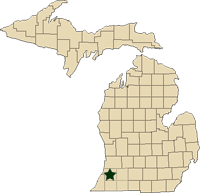 Southwest Michigan
Southwest Michigan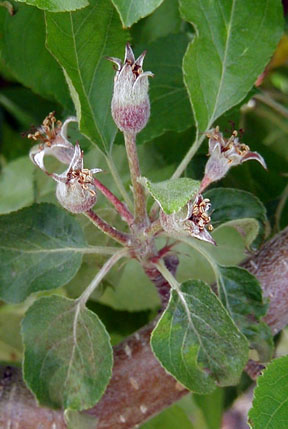 Apple fruitlets the largest is 8mm. Photo credit: Mark Longstroth, MSUE
Apple fruitlets the largest is 8mm. Photo credit: Mark Longstroth, MSUE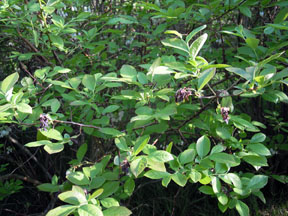 Mummyberry shoot strikes in Jersey blueberries. Photo credit: Diane Brown, MSUE
Mummyberry shoot strikes in Jersey blueberries. Photo credit: Diane Brown, MSUE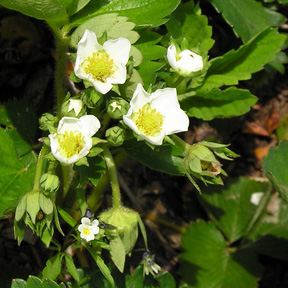
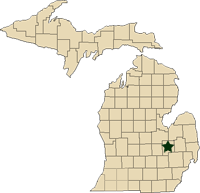 Southeast Michigan
Southeast Michigan